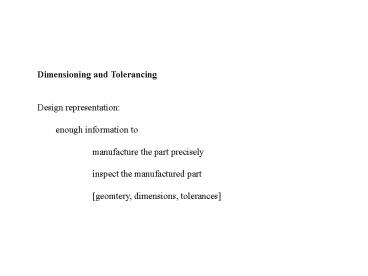Dimensioning and Tolerancing - PowerPoint PPT Presentation
1 / 36
Title:
Dimensioning and Tolerancing
Description:
Title: PowerPoint Presentation Last modified by: Joneja Created Date: 1/1/1601 12:00:00 AM Document presentation format: On-screen Show Other titles – PowerPoint PPT presentation
Number of Views:243
Avg rating:3.0/5.0
Title: Dimensioning and Tolerancing
1
Dimensioning and Tolerancing Design
representation enough information to
manufacture the part precisely inspect the
manufactured part geomtery, dimensions,
tolerances
2
Projections Theoretical technique to map 3D
objects to 2D Dimensions To assist
machinist e.g. distance between centers of
holes Tolerances imprecision in machining
? must specify the tolerance range,
3
What is a good level of tolerance? Designer
tight tolerance is better (less vibration,
less wear, less noise) Machinist large
tolerances is better (easier to machine,
faster to produce, easier to assemble)
Tolerances ?? interchangeability
4
Tolerance and Concurrent Engineering
Why ? Tolerance specification needs knowledge
of accuracy, repeatability of
machines process capability
5
Part 1. Projections. 3D models expensive,
difficult to make gt need 2D representaitons
Images must convey feasible 3D objects
6
Albrecht Durers machine 14??AD (perspective
map)
7
Importance of perspective maps
1. Renaissance architects 2. Modern CAD
systems (a) 3D rendering, image
processing (b) Mathematics of free-form
surfaces (NURBS)
8
Why perspective maps ?
Human sight and perception
larger, farther ? same image size same size,
farther ? smaller image
9
parallel lines converge to a point The
vanishing point (or station point)
10
Effect of vanishing point on perspective map
Image on the picture plane is a perspective of
the 3D object Is the object behind in
perspective view ?
11
Perspectives and vanishing points
Perspectives in mechanical drafting Not good
! (1) parallel lines converge ? misinterpreted
by the machinist (2) Views have too many lines
12
Orthographic views
A mapping where parallel lines remain
parallel How ? Set the vanishing point at
infinity Another problem Back, Sides of object
not visible (hidden surfaces) Solution
Multiple views
13
Orthographic views Language of engineering
communication
14
View direction selection in orthographics Maximiz
e true-size view of most faces
15
Isometric view gives a 3D image
16
Different types of projections
All engineering drawings must be made to scale
17
Part 2. ANSI dimensioning
Datum A theoretical geometric object (point,
line, axis, or plane) derived from a specific
part/feature of a datum feature on the
part. Uses (1) specify distance of a feature
from the datum (2) specify a geometric
characteristic (e.g. straightness) of a
feature
18
Feature A geometric entity on the part, (hole,
axis, plane, edge)
Datum feature An actual feature of a part, that
is used to establish a datum.
Basic Dimension The theoretically exact size of
a feature or datum
19
Limits The max/min allowable sizes Largest
allowable size upper limit Least allowable
size lower limit.
LMC (Least Material Condition) MMC (Maximum
material Condition)
20
Conventions for dimensioning
(a) Specify tolerance for all dimensions (b) All
necessary , sufficient dimensions X
over-dimensioned X X under-dimensioned
X Reference dimensions Redundant
dimensions, in ( ) (c) Dimensions should be
(i) marked off the datum feature (ii) shown
in true-size view (iii) shown in visible view
21
(No Transcript)
22
Part 3. Mechanical Tolerancing
Conventional Tolerancing
(a) Size of a feature Specified by a basic
size, and tolerance 2.500.03 upper limit
lower limit No of digits after decimal ?
precision
23
Unilateral and Bilateral Tolerances
24
Conventional Tolerancing..
(b) The type of fit between mating features
Designer needs to specify basic dia, tol of
shaft Ss/2 basic dia, tol of hole
Hh/2 Allowance a Dhmin Dsmax.
25
Standard fits
26
The hole-basic specification convention
Holes are made by drills
27
Generalization of hole-basic/shaft-basic MMC
Maximum material condition LMC Least material
condition Hole at MMC ? at the lower
limit Hole at LMC ? at the upper limit
28
Geometric Tolerancing
Problems in Conventional tolerancing (a)
Assumes perfect surfaces (b) No use of
Datums (c) No specification of form
tolerances (d) Xt/2, Yt/2 ? rectangular
tolerance zone (cylindrical preferred)
29
Datums A theoretical feature (e.g. plane,
line) Serves as a global coordinate frame for
the part during different activities such
as design, manufacturing and inspection.
Each design must specify the datum
planes (or other datums)
30
Datum feature The actual plane on the part
(imperfect) corresponding to a (perfect) datum
plane
Sequence of establishing datums PRIMARY (3
points) ? SECONDARY (2 points) ? TERTIARY (1
point)
31
ANSI symbols for geometric tolerancing
32
Different allowed notations (ANSI)
33
Location tolerances
Conventional system rectangular tolerance zones
True Position Tolerancing circular (cylindrical)
tolerance zone
34
Form Tolerances
35
Form Tolerances
36
Form Tolerances































